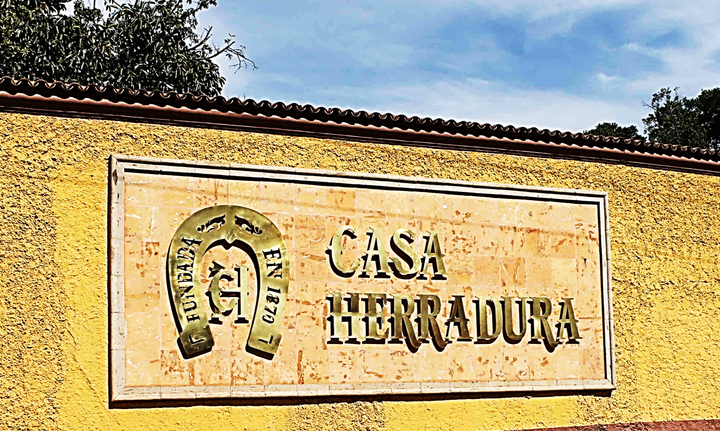
The Herradura Distillery
The Grupo Industrial Herradura is a tequila distiller located in the La Hacienda de San José del Refugio in the town of Amatitán in the lowlands of Jalisco. Amatitán, is located just nine miles south of the town of Tequila. Both towns lie in the valley beneath the shadow of the Tequila Volcano that sits in the heart of Jalisco’s tequila producing zone. Amatitán is a center of tequila production and claims the oldest known tequila distillery. Along with the town of Tequila, the area is considered the original heartland where tequila was first developed.
In 2008, Claudio Jimenez Vizcarra the owner of El Caballito Cerrero ranch and of the associated Caballito Cerrero tequila brand produced there, uncovered an open-air mescal factory complete with stone-lined pit ovens, fermentation vats and a primitive tahona (an animal powered mill stone used to crush cooked agave), which he claimed dated back to the early 16th century. Since this area of Mexico was only conquered by the Spaniards in 1530 and was not completely pacified until after the Mixton War in 1542, the primitive distillery is among the earlier, perhaps even the first, to distill the fermented sap of the agave into what was then called mezcal wine.
The distillery produces two well-known brands of tequila—Herradura and el Jimador, both premium brands of tequila made from 100% agave sugars. In recent years, Herradura has been second only to Jose Cuervo and Sauza in the United States, while el Jimador has been the best-selling tequila in Mexico since 2002.
Herradura: A Tequila Story
The first known owner of the Hacienda where Herradura is located was Jose Feliciano de la Trinidad Romo Escobedo. He purchased the La Concordia ranch in 1802. There is no record of whom the original owner was. The ranch came with a mezcal factory that had been operating for some time. Romo, who had recently been ordained a Roman Catholic priest, apparently kept the distillery in production.
The ranch was renamed Hacienda del Padre (The Priest’s Hacienda) by Father Romo in 1826, when he built a new main house on the property. The structure remains standing and is part of the distillery’s grounds. The term hacienda is often used interchangeably to refer both to a principal residence as well as the functioning agricultural property that surrounds it.
Technically a hacienda is a self-sustaining agricultural property. That means it must provide its own sustenance, maintain livestock and other farm animals, as well as grow its own food beyond whatever crops it produces for commercial purposes. It needs its own blacksmith shops and workshops to manufacture the tools and machinery it needs. It must provide housing to the owner’s family, typically in the form of a grand residence, as well as housing for all the employees who work there.
The living and work areas of a hacienda are typically walled. In addition, it needs to have a church or chapel to administer to the religious needs of the inhabitants. The requirement of a chapel as a prerequisite for the designation hacienda has continued to this day. All the historic, hacienda-based distilleries retain a chapel. Even the Patrón Hacienda, which is a relatively new construction, has a chapel as part of the distillery complex.
In 1858, the hacienda was inherited by the three Zalazar sisters. Only one of the sister’s names is known, Josefa. The sisters have been described as either the nieces or the godchildren of Father Romo. They might have been both. Josefa Zalazar hired Félix López to manage the hacienda and its distillery. In 1866, the Zalazar sisters were forced to turnover part of the hacienda to Felix Lopez in lieu of unpaid wages.
By 1870, he acquired the balance of the hacienda and renamed the property Hacienda San José del Refugio—the name under which it’s known today. That same year the hacienda was registered as an official distillery, hence the 1870 date that appears on Herradura’s labels to commemorate its founding. The brand name “Tequila Herradura,” however, wasn’t registered with the Mexican government until 1928. Herradura means horseshoe in Spanish and has been immortalized as the distillery’s logo and is featured prominently on bottles of Herradura Tequila.
There are various versions of the origins of the horseshoe logo. The most popular version is that one day while examining his agave fields Félix López noticed something glinting golden on the ground. When he went to investigate, no doubt hoping to find a buried treasure, he found an old horseshoe instead. López kept the horseshoe at the distillery for good luck. Another version of the story attributes the discovery to Aurelio López Rosales, Félix’s son. Regardless of who discovered the horseshoe, by 1928 it had officially been adopted as the distillery’s logo.
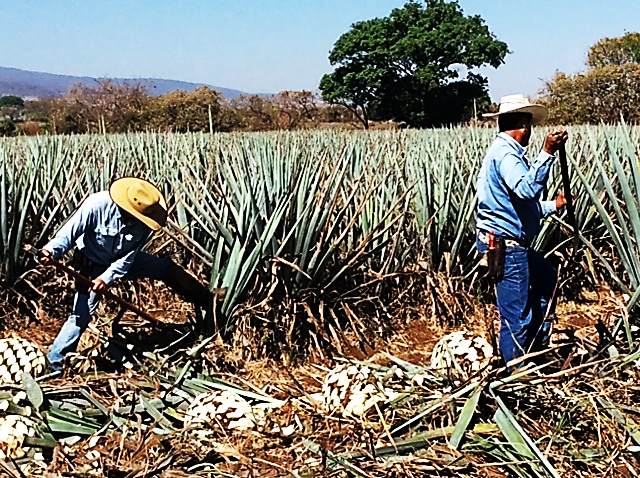
Jimadors harvesting piñas at Herradura
There is one other unusual feature of Herradura’s horseshoe, the horseshoe opens downward. Traditionally horseshoes are displayed with the open end up so that the “luck” in the horseshoe does not run out. This too has conflicting explanations. One version is that the distillery wanted its good fortune to run out to all its patrons. Herradura’s PR people have another explanation, pointing out that the horseshoe is inverted in the traditional depiction of a good luck charm when tequila is being poured out of the bottle signifying that good luck will come to those who drink Herradura. Plausible? Well that’s what PR people are supposed to do.
Félix López married Carmen Rosales. The couple had two children, a son Aurelio and a daughter María de Jesús. López modernized and expanded the distillery. That facility remained in use till 1963, and is preserved today as a museum on the modern hacienda’s grounds. The museum and the original main house are still owned by the Romo de la Peña family. Félix López died in 1878. The distillery was managed by his wife Carmen and by her brother Ambrosio Rosales and his wife Elisa Gomez Cuervo. The latter was an estranged member of the tequila industry’s first family, the Cuervos.
Eventually, the business was taken over by Aurelio López. Aurelio continued to expand the distillery and to add agave fields to the hacienda. By 1892, the hacienda owned approximately 13,366 acres of land. At that time, there were 13 tequila distilleries operating in Amatitán.
In the late 19th century the railroads came to Jalisco. The new transportation links made it possible to ship tequila not only to the rest of Mexico but to the United States as well. It was at this time that tequila, then misnamed as Mexican whiskey, first began to regularly appear in the U.S. The availability of tequila throughout Mexico helped to transform it from a traditional Jalisco drink into a broadly Mexican one.
In addition to preserving the historic style of making tequila using stone fermenters buried in the ground and the traditional tahona wheel, the old distillery grounds also have several other interesting features. First, they have a long-standing reputation for being haunted. Not only is the old distillery itself haunted but the surrounding fields are said to host regiments of soldiers going off to battle. The old distillery grounds also host a series of secret tunnels that allow passage from the hacienda out to the surrounding fields.
Those secret passages proved to be particularly useful during the Cristero Rebellion in the 1920s. The rebellion, which was centered in Jalisco and the surrounding provinces, pitted the Mexican government against the Catholic Church and its supporters. The rebels opposed the Mexican government’s anti-clerical, anti-Catholic and secularist policies, in particular, Mexico City’s desire to shut down many local and village level Catholic celebrations. Both Aurelio and his sister María de Jesús sympathized with the rebels. On one occasion, when government troops surrounded the hacienda, Aurelio and María, as well as rebels that had been hiding at the distillery while receiving medical treatment, were able to escape via the secret tunnels.
The distillery and the surrounding hacienda eventually passed into the hands of David Rosales, Aurelio’s cousin. It was David Rosales who was responsible for registering the Herradura name and adopting the horseshoe logo. By 1938, however, a combination of overproduction and the violence that accompanied the Mexican Civil War (1914-16) and the Cristero rebellion (1926-29) had reduced the number of distilleries in Amatitán to three. During this period, the hacienda lost about one-fifth of its acreage to land reform.
In the late 1950s Gabriela de la Peña took over the management of the company and ran it for the next four decades. She was eventually replaced by her sons, Jose Guillermo and Pablo Romo de la Peña. The distillery would remain in the hands of the Peña Rosales and Romo de la Peña families until 2006, when it was sold to U.S. liquor giant Brown-Foreman for $776 million.
The company experienced a steady period of growth over the second half of the 20th century. In 1955, Bing Crosby and life-long friend and fellow entertainer Phil Harris obtained import rights to the Herradura brand and organized a company to launch Tequila Herradura in the U.S. market. A new distillery was built in 1963, and it underwent several expansions over the course of the next several decades.
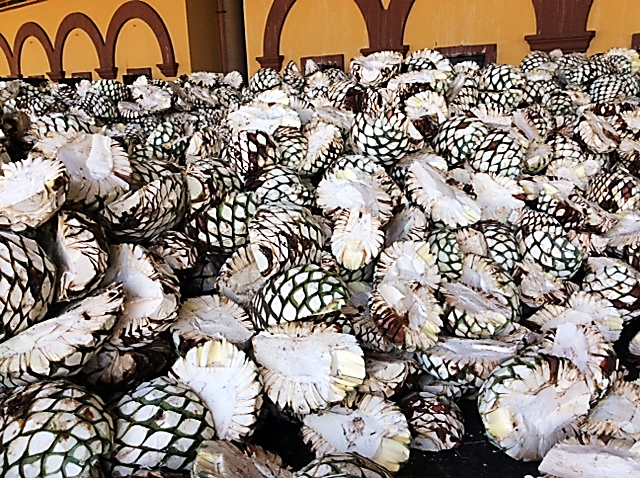
Piñas prior to baking
In 1974, Herradura introduced the first Reposado tequila. Reposados were aged in white oak barrels for a period of two to 12 months. From 1974 through 1981, Herradura’s Reposado was the only one on the market. In 1995, Herradura introduced the first Extra Añejo Selección Suprema. Extra Añejo’s were aged for a period of at least three years. Herradura’s Selección Suprema was aged for 49 months. Selección Suprema went on to win Best Tequila in the World at the San Francisco World Spirits Competition in 2000 and 2001.
In 1994, the brand el Jimador was launched with a Reposado that was aged for four months; also, a 100% Añejo tequila. It’s named for the laborers who harvest the agave piñas in the field. El Jimador sold 10,000 cases its first year, but increased its sales 10-fold the next year. By 2002 it had become the best-selling tequila in Mexico, a position it has retained to this day. Its market share is currently around 12 percent. No small feat considering the domestic Mexican market is crowded with more than 1,200 competing tequila brands. In 1998, el Jimador introduced an Añejo tequila and in 2000, it introduced a Blanco tequila.
Between 1982 and 1992, Herradura doubled its output, becoming the 11th largest tequila producer in Mexico. Exports, however, were only about 10 percent of its total sales. At the time, exports, primarily to the U.S., were dominated by mixtos tequilas, which included up to 49% non-agave sugars. The Romo de la Peña family, however, strict traditionalists, refused to abandon the historic 100% agave standard.
By 1995, production had increased to 300,000 cases, roughly one-third of which were el Jimador. Revenues had increased to around $34.5 million. The distillery was now the seventh largest tequila producer in Mexico, although it still lagged far behind the market leaders, Cuervo and Sauza.
By 1999, sales of el Jimador had increased to more than 850,000 cases. In 2000, however, the outbreak of a combination of a fungal infection, Fusarium oxisporum, accompanied by a bacterial infection, erwinia caratavora, decimated agave production at a time of rising demand for piñas, the raw material from which tequila was made. Prices for piñas increased some 15-fold over an 18-month period. The price hike led the company to temporarily abandon its 100% agave standard for the distillation of el Jimador and, for the next several years, it began to incorporate non-agave sugars into its production.
Sales of el Jimador increased to 1.2 million cases in 2000, and 1.4 million cases in 2002. That year el Jimador’s domestic market share reached 22 percent of all tequila sold in Mexico. The brand represented 62 percent of Herradura’s revenues, which had now increased from $43 million in 1996, to $220 million in 2002. A five-fold increase in just six years.
Export sales continued to lag, however. By 2003, foreign sales, mostly to the U.S., amounted to 72 percent of the tequila industry’s output, up from 49 percent in 1999. Although by now it was exporting to 63 countries around the world, Herradura’s foreign sales were still only 17 percent of its revenues. The company was represented in Europe by Osborne, the Spanish brandy manufacturer, and in the U.S. by Sazerac.
By 2004 prices for blue agave piñas had returned to their historic levels. Overall prices dropped from 16 Mexican pesos/1.50 USD a kilo (2.2 lbs) to between two to four Mexican pesos/20 to 40 cents USD. In 2005, Herradura sold 380,000 cased of its premium tequila, 70,000 cases of which were exported to the U.S., and 1.4 million cases of el Jimador, of which 150,000 cases were exported to the U.S. The next year, the company was acquired by Brown Forman. Under Brown Forman the company export sales have increased significantly and now reach over 140 countries. Shortly after the acquisition, el Jimador returned to using 100% agave sugars in its tequila.
Making Tequila at Herradura
The production of tequila at Herradura follows the traditional production process with, however, several notable differences. The company controls approximately 55,000 acres of agave fields, about 18 million agave plants in total, and relies on a combination of its own production and purchases from local farmers. In 2016, the company’s 256-acre distillery complex processed 300 tons a day of piñas, more than 3.5 million piñas a year, with a total weight of more than 90,000 tons.
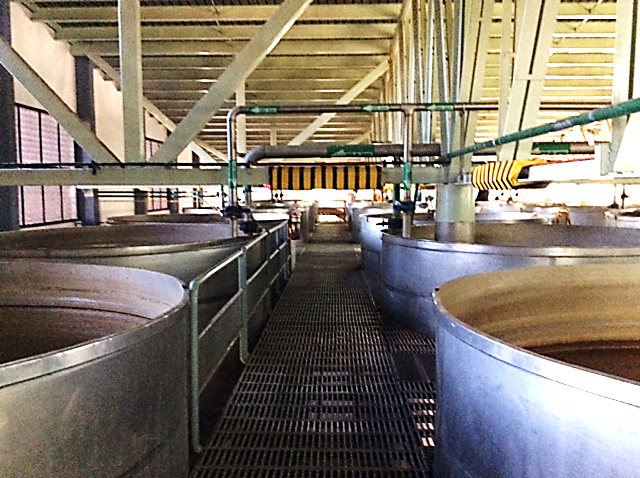
Fermenters at the Herradura distillery
The piñas at Herradura are closely trimmed by the jimadors using a traditional tool called a coa, a cross between an axe and a hoe, to eliminate the bitter compounds at the base of the leaves. Piñas are then split in two and the resinous heart, or el codollo, is removed from the piña. The codollo can impart bitter flavors to the mosto, which are passed along to the tequila during distillation.
All the piñas are processed in traditional clay-lined stone ovens. Steam is injected into the ovens to cook the piñas. Herradura operates from 15 to 23 ovens at the distillery. Each oven holds approximately 45 tons of piñas. It does not use any autoclaves. The cooking process last for approximately 26 hours at a temperature of 90-100 degrees C, followed by a 24-hour cooling period.
During cooking, a syrupy nectar naturally flows from the agave. This is called miel de agave or agave honey. The juice is collected via a drainage system in the ovens. It is rich in sugar and has a pronounced earthy aroma. Once cooked the piñas are processed through a shredder and milled through five sets of rollers to extract the juice. The process is repeated a second time during which the pulp is sprayed with water to extract any remaining agave sugar.
The juice that has been pressed from the agave fibers is called jugo de agave or agave juice. It has a lower sugar content than the agave honey. It will also have bits of agave fiber or bagasse floating in it. The agave juice is blended with agave honey and diluted with water to a concentration of about eight to 12 percent percent sugar. It is now called mosto. From there it is moved to 60,000 gallon fermenters.
The fermentation lasts for approximately 72 to 120 hours. Herradura is unusual in that it relies on wild yeast to initiate the fermentation of the cooked agave juice or mosto. Most of the larger distilleries rely on proprietary yeast strains or commercial yeast strains suited for tequila, like Danstil 493 EDV, to ferment the mosto.
Wild yeast fermentation typically results in a much more diverse yeast flora. Up to five different sources of yeast, representing over 300 different species of yeast, are typically associated with a “wild or natural” fermentation. Herradura does not add any fertilizers to the fermenting mosto. In addition, wild fermentations, depending on their length, can also be influenced by the bacteria Zymomonas mobilis. The bacteria live on the skin of the agave plants and play an important role in the metabolization of acetaldehyde, a byproduct of fermentation, into ethyl alcohol. Zymomonas fermentation typically adds more pronounced fruity and floral aromas to tequilas.
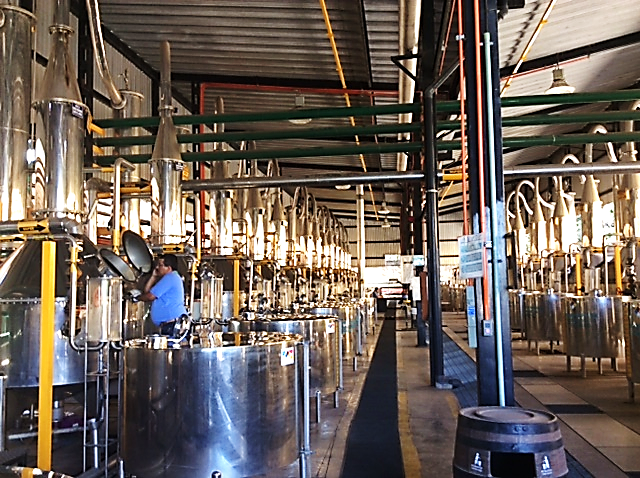
Stills at the Herradura distillery
Once the mosto has stopped fermenting and cooled down it is referred to as mosto muerto or dead mosto. The dead mosto or wash has an alcoholic strength of between five percent and seven percent, and exhibits a complex beer-like flavor that can include intense flavors ranging from citric to fruity to bitter. Herradura has a total of 60 fermenters with a total capacity of 3.6 million liters.
At Herradura the wash undergoes a two-stage distillation in pot stills. The stills are stainless steel and are copper lined inside. The copper absorbs sulfurous compounds that are produced as a byproduct of distillation and that can impart off tastes to the tequila. Steel stills are more economical to operate and last longer than traditional copper stills. Herradura operates a total of 60 pot stills. The stills are all the same shape and differ only in size. The wash stills have a capacity of 5,000 liters, while the spirit stills have a capacity of 4,000 liters. Both stills are charged to 75 percent of capacity.
The first distillation produces a distillate called ordinario. It typically has an alcoholic strength of 20 to 24 percent alcohol by volume (ABV). The ordinario is distilled a second time to produce tequila at an ABV of 57 percent. Herradura has released a 55% ABV, 110 proof tequila in Mexico and the U.S. This is the highest proof at which tequila can be released according to Mexican regulations. The first distillation cycle lasts approximately 3.5 hours. The second distillation cycle lasts for six to seven hours. The corazon or heart cut, the portion of the distillation that is bottled for sale, lasts for five hours and is preceded by a foreshots run of 30 minutes.
Following distillation, the new tequila is casked. Most of Herradura’s tequila is aged in ex-bourbon barrels. In addition, the distillery has aged reposado tequila in used port and cognac barrels. The blanco is typically aged for 45 days while the resposados are aged for 11 months. The Herradura Añejo is aged for around 24 months while the Extra Añejo Selection Suprema is aged for a total of 49 months.
Unlike Scotland or Cognac, where temperature variations are less pronounced and humidity levels in the aging warehouses tends to be quite high, temperature variations in Amatitán are quite pronounced and the ambient climate is quite dry. The result is that the influence of the wood on the tequila is accelerated, typically two to three times faster than in cooler climates like Scotland. Moreover, the evaporation of the aging tequila is also more pronounced, averaging about five to ten percent a year. In the first year of aging, it is usually closer to 10 perccent.
Herradura’s core range consists of Herradura Blanco, Herradura Reposado, Herradura Antigo, Herradura Añejo, Herradura Ultra, Herradura Extra Añejo Selection Suprema and Herradura Collection de la Casa. The best-selling expressions are the Reposado, Añejo and Selección Suprema.
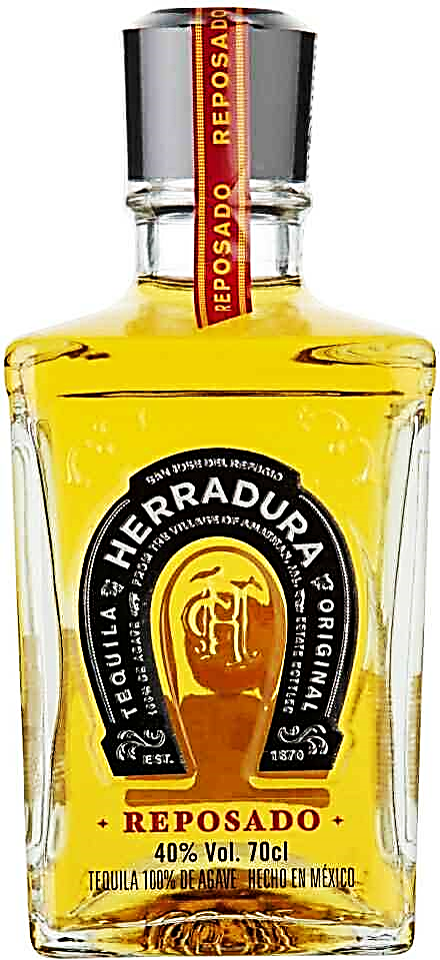
Herradura Reposado, 100% Agave Tequila, 40% ABV, 750 ml
The Herradura Reposado has a light amber color. It’s aged in American oak for 11 months. On the nose, it offers fruity and floral agave notes with just a hint of dried herbs and earth. There are sweet caramel elements, followed by some orange notes and a black truffle, earthy-woody character in the background. On the palate, there is the sweet caramel taste of cooked agave combined with earth and dried herb notes. There is some wood spice with notes of vanilla and smoke and just a hint of cinnamon. It offers a medium weight on the mouth with a slightly viscous, buttery quality. The finish is medium length, emphasizing the earthy and herbal notes that lowland agaves are known for, followed by a long, lingering finish of wood notes and spice.
Appearance: 8/10, Nose: 25/30, Palate: 26/30 Finish: 27/30. Overall Score: 86/100

Herradura Añejo, 100% Agave Tequila, 40% ABV, 750 ml
The Herradura Añejo has a deep amber color. It’s aged in American oak for 24 months. On the nose it presents the earthy, herbal woody aromas of lowland agave. There is a distinct sweet caramel note. The spiciness is more apparent here than in the reposado, with vanilla, cinnamon and even a slight touch of cloves, followed by tropical fruit notes of pineapple, banana and a hint of dark chocolate. As it opens up, more tropical fruit notes emerge, along with some dried cherry and a little blueberry.
On the palate, there is a noticeable oily, sweet, viscous quality. There is sweet fruit, more dried than ripe, some caramel and a floral potpourri element, followed by vanilla, cinnamon, some clove and pepperiness. The latter starts slowly and then builds toward the finish. The wood is well integrated, hangs in the background, and complements the earthy and herbal notes nicely.
The finish is long with earthiness, dried fruit notes, cinnamon, and a sweet peppery finish that lingers in the end.
Appearance: 9/10, Nose: 27/30, Palate: 26/30, Finish: 28/30. Overall Score 90/100
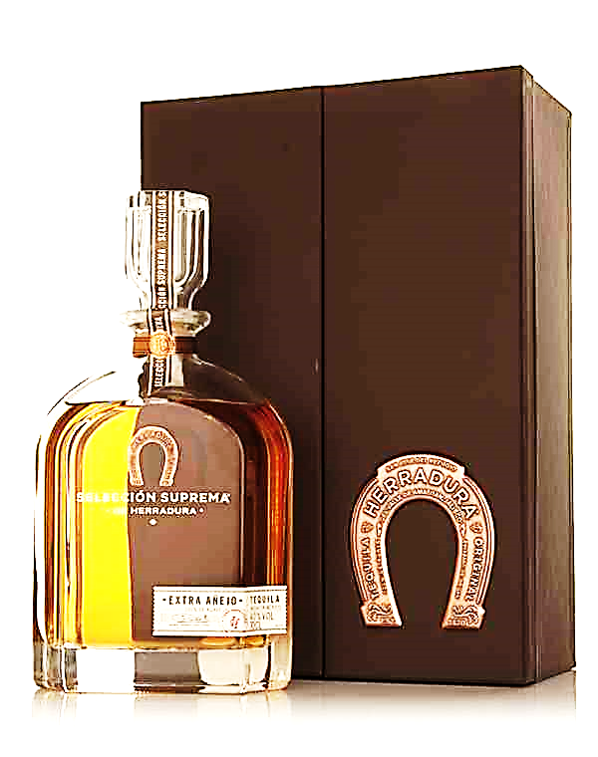
Herradura Extra Añejo Selección Suprema, 100% Agave Tequila, 40% ABV, 750 ml
The Selección Suprema has a dark gold, amber color. It’s aged in American oak for 49 months. On the nose, there are distinctive fruit and floral notes including cherry, orange, some strawberry and indistinct dried and tropical fruit, followed by some slight smoke. The characteristics earthy, herbal agave aromas are present but well integrated. There is sweet caramel, vanilla, cinnamon and other wood spices.
On the palate there is a sweet, oily viscosity with a pronounced creamy, mouth weight. There are caramel notes, followed by dried fruit notes, caramel and dried herbs and earth. Vanilla, cinnamon, cloves follow, with some wood notes in the background, all wrapped up in a distinctive white ginger pepperiness that steadily builds.
The finish is exceptionally long, with sweet, dried fruit notes, caramel, cooked agave notes, vanilla and cinnamon and a pepperiness that persists long after the finish.
This is an exceptional tequila, which offers complexity and nuance and an exceptional long finish. It is easily one of the best sipping tequilas ever made.
Appearance: 9/10, Nose: 29/30, Palate: 28/30, Finish: 29/30. Overall Score: 95/100
Casa Herradura is a traditionalist, which has persisted in crafting a fine authentic tequila, even when convention dictated that it should adulterate its quality and the marketplace could not see beyond the ubiquitous tequila shot or the sea of salt rimmed margaritas to appreciate exceptional sipping tequilas. As other distillers scramble to craft top quality premium tequilas to meet the burgeoning market demand, Casa Herradura can take satisfaction in the knowledge that it was there all along.
